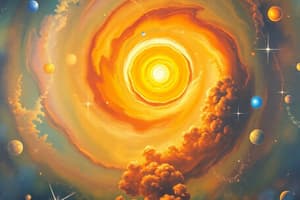Podcast
Questions and Answers
The Steady-state theory proposed by Fred Hoyle suggests that the universe is continuously created and unchanging.
The Steady-state theory proposed by Fred Hoyle suggests that the universe is continuously created and unchanging.
True (A)
The Big Bang Theory posits that the universe began from a singularity approximately 13.7 billion years ago.
The Big Bang Theory posits that the universe began from a singularity approximately 13.7 billion years ago.
True (A)
Hubble's Redshift Theory concludes that the universe is contracting as stars shift to red.
Hubble's Redshift Theory concludes that the universe is contracting as stars shift to red.
False (B)
The Electroweak Epoch marks the period when protons and neutrons first form from quarks.
The Electroweak Epoch marks the period when protons and neutrons first form from quarks.
During the Dark Epoch, light was unable to pass through due to the thickness of Hydrogen.
During the Dark Epoch, light was unable to pass through due to the thickness of Hydrogen.
Quarks are created from photons colliding during the Planck Epoch.
Quarks are created from photons colliding during the Planck Epoch.
Nucleosynthesis refers to the process of creating colors in the electromagnetic spectrum.
Nucleosynthesis refers to the process of creating colors in the electromagnetic spectrum.
The Stellar Epoch is characterized by the emergence of stars including the Sun, which illuminate the previously dark universe.
The Stellar Epoch is characterized by the emergence of stars including the Sun, which illuminate the previously dark universe.
The Steady-state theory was initially proposed in the 1960s.
The Steady-state theory was initially proposed in the 1960s.
The Cosmic Microwave Background (CMB) provided evidence that supported the Steady-state theory.
The Cosmic Microwave Background (CMB) provided evidence that supported the Steady-state theory.
The Universe began expanding during the Hadron Epoch.
The Universe began expanding during the Hadron Epoch.
The primary elements formed during the Atomic Epoch include Oxygen and Nitrogen.
The primary elements formed during the Atomic Epoch include Oxygen and Nitrogen.
Georges Lamaitre's proposals were based on Newton's laws of motion.
Georges Lamaitre's proposals were based on Newton's laws of motion.
The Lepton Epoch involved the formation of neutron-antineutron pairs.
The Lepton Epoch involved the formation of neutron-antineutron pairs.
Spontaneous symmetry breaking refers to the merging of forces into one unified force.
Spontaneous symmetry breaking refers to the merging of forces into one unified force.
Photons played a role in the formation of protons and neutrons during the Lepton Epoch.
Photons played a role in the formation of protons and neutrons during the Lepton Epoch.
Flashcards are hidden until you start studying
Study Notes
Theories about the Origins of the Universe
-
Steady-State Theory
- Proposed by Fred Hoyle, Thomas Gold, and Hermann Bondi in 1948.
- Suggests an infinite and unchanging universe.
- Debunked due to the discovery of the Cosmic Microwave Background (CMB).
-
Big Bang Theory
- Most widely accepted theory for the origin of the universe.
- Suggests rapid expansion 13.7 billion years ago from a single point known as the singularity.
- Proposed by Georges Lemaître, based on Einstein's General Relativity.
- Supported by Edwin Hubble's Redshift Theory; redshift indicates an expanding universe.
- Color spectrum: red = longest wavelength, violet = shortest wavelength; wavelength informs star color perception.
Big Bang Theory Timeline
-
Radiation Era
- Planck Epoch to Grand Unification Epoch: Gravity separates from other forces; matter and energy fluctuate.
- Photons collide to create quarks, antagonizing antiquarks; quarks combine to form protons and electrons.
-
Electroweak Epoch to Inflation Epoch
- Protons and neutrons formed from quarks.
- Inflation period marks exponential universe growth; CMB arises from this phase.
- The process of separating forces is termed spontaneous symmetry breaking.
-
Quark Epoch
- The four unified forces evolve and fully separate.
-
Hadron Epoch
- Emergence of neutrinos, forming primitive nuclei.
-
Lepton Epoch
- Continued presence of neutrinos; creation of electron-positron pairs.
-
Nuclear Epoch
- Atomic nuclei formation, referred to as nucleosynthesis.
-
End of Radiation Era, Beginning of Matter Era
- Atomic Epoch: Formation of the first elements—Hydrogen, Helium, Lithium, Beryllium.
- Dark Epoch: Thick Hydrogen clouds prevent light from traveling.
- Stellar Epoch: Birth of stars, including the Sun, illuminating the previously dark universe.
Current Timeframe
- Present time exists 13.7 billion years after the Big Bang.
- Formation of our Solar System occurred approximately 4.5 to 5 billion years ago.
Theories about the Origins of the Universe
-
Steady-State Theory
- Proposed by Fred Hoyle, Thomas Gold, and Hermann Bondi in 1948.
- Suggests an infinite and unchanging universe.
- Debunked due to the discovery of the Cosmic Microwave Background (CMB).
-
Big Bang Theory
- Most widely accepted theory for the origin of the universe.
- Suggests rapid expansion 13.7 billion years ago from a single point known as the singularity.
- Proposed by Georges Lemaître, based on Einstein's General Relativity.
- Supported by Edwin Hubble's Redshift Theory; redshift indicates an expanding universe.
- Color spectrum: red = longest wavelength, violet = shortest wavelength; wavelength informs star color perception.
Big Bang Theory Timeline
-
Radiation Era
- Planck Epoch to Grand Unification Epoch: Gravity separates from other forces; matter and energy fluctuate.
- Photons collide to create quarks, antagonizing antiquarks; quarks combine to form protons and electrons.
-
Electroweak Epoch to Inflation Epoch
- Protons and neutrons formed from quarks.
- Inflation period marks exponential universe growth; CMB arises from this phase.
- The process of separating forces is termed spontaneous symmetry breaking.
-
Quark Epoch
- The four unified forces evolve and fully separate.
-
Hadron Epoch
- Emergence of neutrinos, forming primitive nuclei.
-
Lepton Epoch
- Continued presence of neutrinos; creation of electron-positron pairs.
-
Nuclear Epoch
- Atomic nuclei formation, referred to as nucleosynthesis.
-
End of Radiation Era, Beginning of Matter Era
- Atomic Epoch: Formation of the first elements—Hydrogen, Helium, Lithium, Beryllium.
- Dark Epoch: Thick Hydrogen clouds prevent light from traveling.
- Stellar Epoch: Birth of stars, including the Sun, illuminating the previously dark universe.
Current Timeframe
- Present time exists 13.7 billion years after the Big Bang.
- Formation of our Solar System occurred approximately 4.5 to 5 billion years ago.
Studying That Suits You
Use AI to generate personalized quizzes and flashcards to suit your learning preferences.



